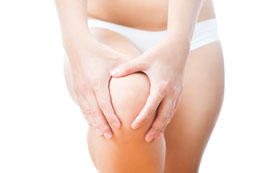Hip and leg pain can occur both for traumatic as well as non traumatic reasons. This article provides a brief overview on pain experienced in the legs and hip region.

The hip joint is one of the most vital joint of our body, in which the femur or the large-thigh bone is attached to the pelvis. The top end of the femur is round like a ball, and it is fitted into the socket of the pelvis joint. This joint bears the entire body weight, and it helps us in sitting, walking, running, etc. When it suffers injury or degeneration, then it gives rise to pain in the hip and legs.
Causes
There are numerous causes that can lead to this painful condition. Most of them are caused due to some problem of the hip joints, and the resultant pain is radiated down towards the thighs and legs. Some of the most commonly found causes have been discussed below.
Fracture
Sports-related injuries, motor-vehicle accidents, a bad fall, etc., can lead to fracture of the hip bone. Degeneration of the bones with increase in age can lead to a health condition called osteoporosis. In this condition, the bones become so fragile that the elderly can get hip fracture even while carrying out daily activities.
Dislocation
Another form of traumatic injury is when the hip joint gets dislocated. It can be identified with the help of symptoms like extreme pain that make the movement of the leg difficult, limited rotation of the hip, and shortening of legs or abnormal-leg positioning.
Peripheral Artery Disease
This results in poor-blood circulation, and thus the oxygen supply to the legs gets affected. As a result, the affected leg is prone to infections. It mostly affects one leg only, but it may affect both the legs as well. A person affected by this disease has a higher risk of getting a heart attack or stroke.
Arthritis
Osteoarthritis and rheumatoid arthritis are the two major forms of arthritis that affect the hip joint, and cause chronic leg and hip pain. Osteoarthritis is a non-inflammatory arthritis found in people who are above the age of 55. It occurs when the cartilage present in the hip joint wears out. On the other hand, rheumatoid arthritis is an inflammatory arthritis destroying the cartilage, bones, and tendons of the joint. It can affect much younger people who are in the age group of 35-50.
Other Causes
If any nerve roots or the sciatic nerve present in the lower-back region get irritated or compressed then it can lead to pain in the hip region and legs. This pain is known as referred pain as the origin of the pain is lower-back region, but it gets radiated to the hip and lower part of the legs. The cartilage present in the hip joint is known as labrum, which ensures smooth movements of the hip joint and the legs. Tear in this cartilage because of injury or disease like arthritis gives a radiating hip pain, and often gives a locking sensation with certain movements of the joint.
Treatment
The exact cause behind such pain is ascertained by the physician with the help of physical examination and various laboratory tests like X-ray, CT Scan, MRI Scan, blood test, etc. If the injury is minor, then rest, application of ice ,and elevation of the leg can help alleviate the pain. In more severe cases, pain-relieving medicines or injections are prescribed by the doctors to control the pain. Physical therapy is recommended for those who are affected by arthritic or sciatica pain. For a serious case of dislocation or fracture, surgery is a must. If all the non-surgical treatments of arthritis and sciatica fail to provide relief, then also surgery is the only option left.
The causes behind the pain can be controlled to some extent if we maintain a healthy lifestyle and a proper body weight. This can be achieved by eating healthy foods, drinking enough water, and exercising regularly. You can prevent many of the injuries of the hip joint if you warm up your body before doing any physical activity.
Disclaimer:
This Buzzle article is for informative purposes only, and should not be used as a replacement for expert medical advice.


 The hip joint is one of the most vital joint of our body, in which the femur or the large-thigh bone is attached to the pelvis. The top end of the femur is round like a ball, and it is fitted into the socket of the pelvis joint. This joint bears the entire body weight, and it helps us in sitting, walking, running, etc. When it suffers injury or degeneration, then it gives rise to pain in the hip and legs.
The hip joint is one of the most vital joint of our body, in which the femur or the large-thigh bone is attached to the pelvis. The top end of the femur is round like a ball, and it is fitted into the socket of the pelvis joint. This joint bears the entire body weight, and it helps us in sitting, walking, running, etc. When it suffers injury or degeneration, then it gives rise to pain in the hip and legs.